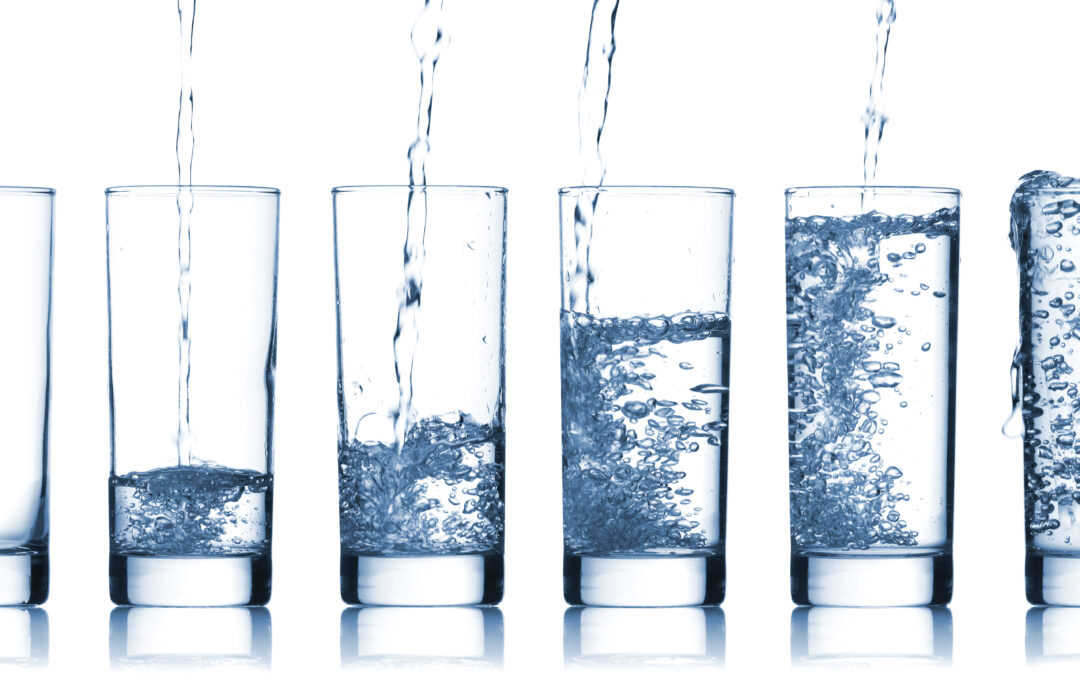With the heat and humidity of summer upon us, this edition of Coach’s Corner will quench your thirst for knowledge by shining a spotlight on a wellness superstar: WATER.
It is no coincidence that literature, film, and folklore often refer to water as a symbol of life and cleansing. Take the timeless idea of the fountain of youth, with its fictional springs of an elixir that promises life eternal. Still, the incredible function of water within our bodies is not fictional. As evidenced in sources such as medical journals and health publications, water contributes to health and longevity. Read on, and you will quickly come to realize why water is worthy of such potent imagery and life-affirming associations.
EDUCATION & AWARENESS
H2O
-regulates body temperature.
-maintains blood volume and oxygen delivery.
-aids in nutrient absorption.
-eliminates waste.
-helps to improve mood and cognitive function.
-assists kidney function.
-lubricates tissues and joints.
-produces saliva.
-prevents some chronic illnesses.
-boosts energy and physical performance.
(1,2)
This list is not exhaustive, but it is demonstrative.
Now that we have established the benefits of staying hydrated, let’s consider two simple questions:
- How much water should you drink daily?
- How much water do you drink daily?
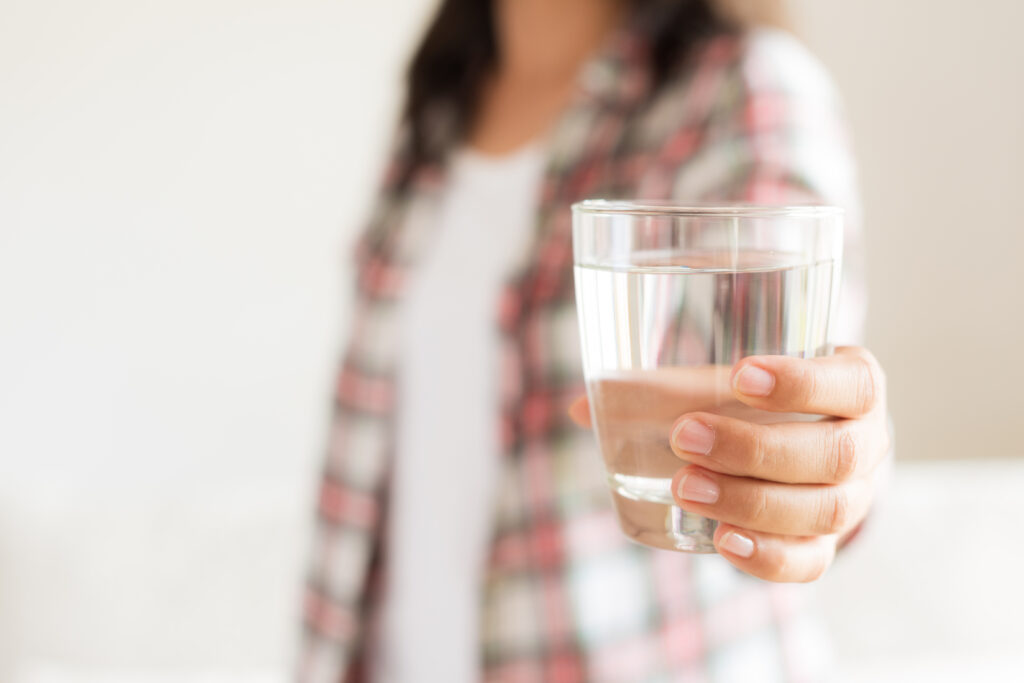
If you site the rule of thumb “8 cups per day” to answer the first question, then you are not alone. The fact is, this one size fits all rule is rather flawed. Optimal amounts vary based upon factors such as age, activity level, medication and health history, as well as climate. Still, there are general guidelines for getting started.
First, it is important to separate water intake from fluid intake and, to that end, where/how we consume fluids.
Did you know? Recent guidance suggests the following for *OVERALL DAILY FLUID CONSUMPTION: 125oz for adult male and 91oz for an adult female. (3) However, in addition to plain water, this includes water from food and other beverages. The next tier advises that 80% of those ounces should come from beverages. *That is 100oz per day for an adult male and 73oz per day for an adult female. (4) The guidance doesn’t offer a specific framework for how much should be water. That said, evidence abounds to promote water as the healthiest choice.
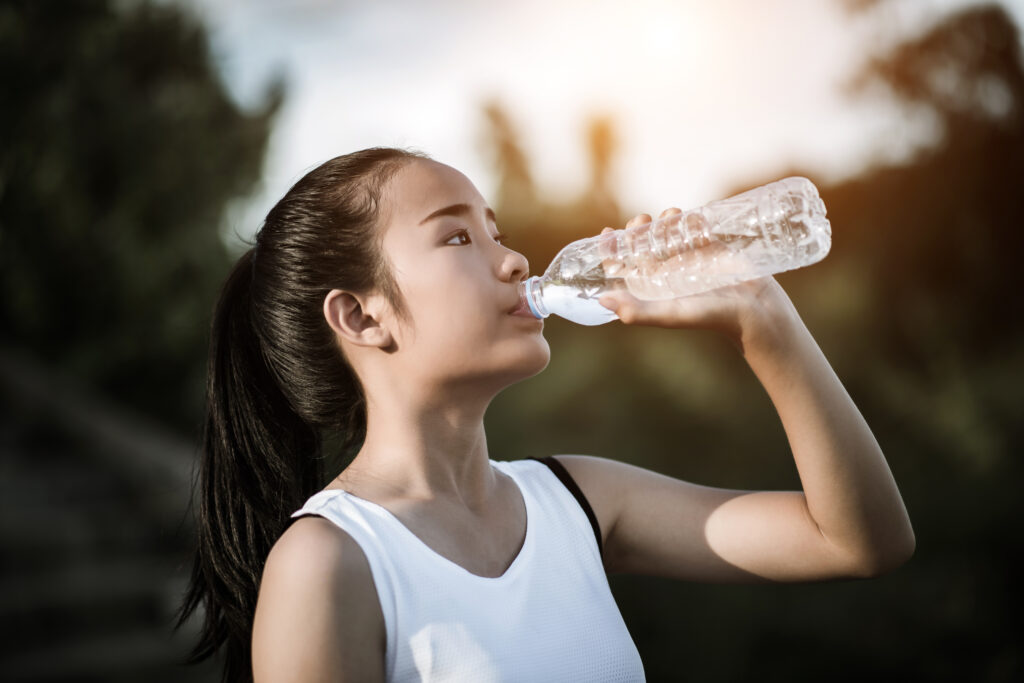
*Note, these numbers target the average person. Special considerations apply for those who live and work in hot climates, spend significant amounts of time outdoors, or regularly exercise and sweat more than others. Of course, you lose more than water in your sweat. That topic is deserving of a separate post. Still, my guess is that most people who read this column will not report that they regularly meet those guidelines.
Did you know? Our bodies are quite adept at sending physical indicators of dehydration. First is thirst. If you wait until you are thirsty to sip, then you are already behind. Drink to prevent thirst. Second is urination. Your urine should be very pale or colorless. The darker your urine is, the more severe your state of dehydration. A strong odor may also accompany the dark color. There are myriad dehydration symptoms, including, but not limited to, chapped lips, dry skin, headache, and even hunger. Keep in mind; these may also be linked to other conditions.
Did you know? We get up to 20% of our water needs met through foods with high water content. (3) (i.e., celery, watermelon, apples, broccoli) Our bodies extract water from whole foods such as vegetables and fruit. Unfortunately, studies reveal that people who do not drink enough water also tend to eat lower quality diets. (5) Another conclusion, following this tangent, is that an awareness of water consumption likely syncs with an awareness of nutrition across the food groups. Consumers in this category may be chronically dehydrated and stand to gain the most, overall, from this message.
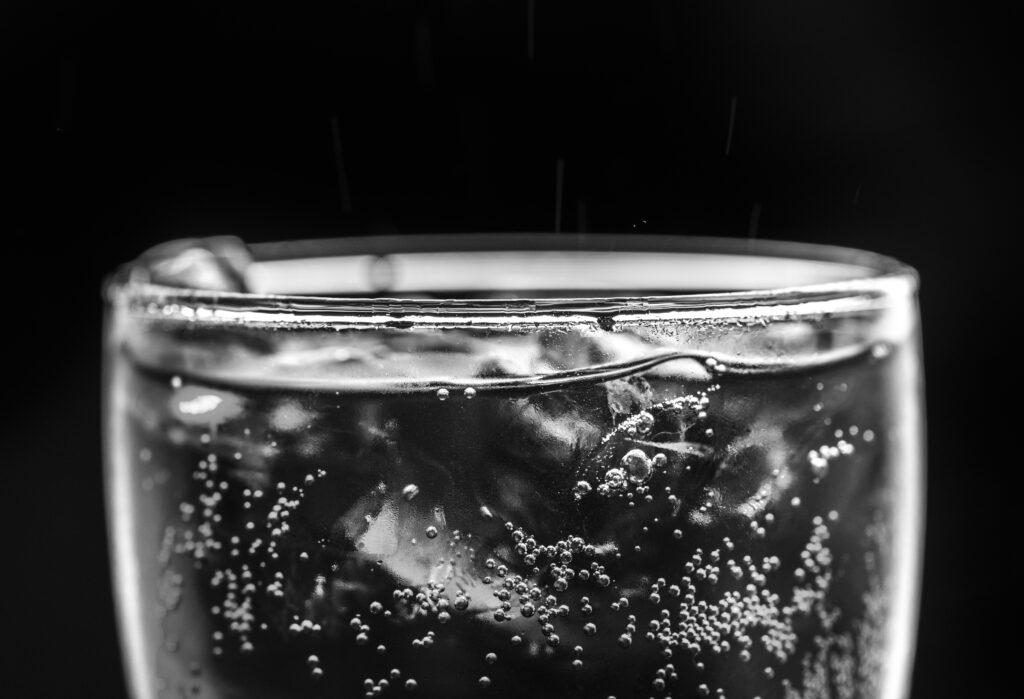
Did you know? Despite the buzz, there has been no link established between carbonated water and decreased bone density. Instead, studies have suggested that caffeine in sodas translates to bone loss, NOT the carbonation. (6,7)
GOAL SETTING
Now armed with the facts, how will you take action? Think back to your answer to question two. If you find yourself among the many folks who have fallen short of the recommendations, might you consider setting a goal? Your response to the second question offers a perfect starting point by which to measure progress. The next steps include identifying and overcoming obstacles.
People commonly run into one of three roadblocks:
Roadblock: Water is bland or tasteless.
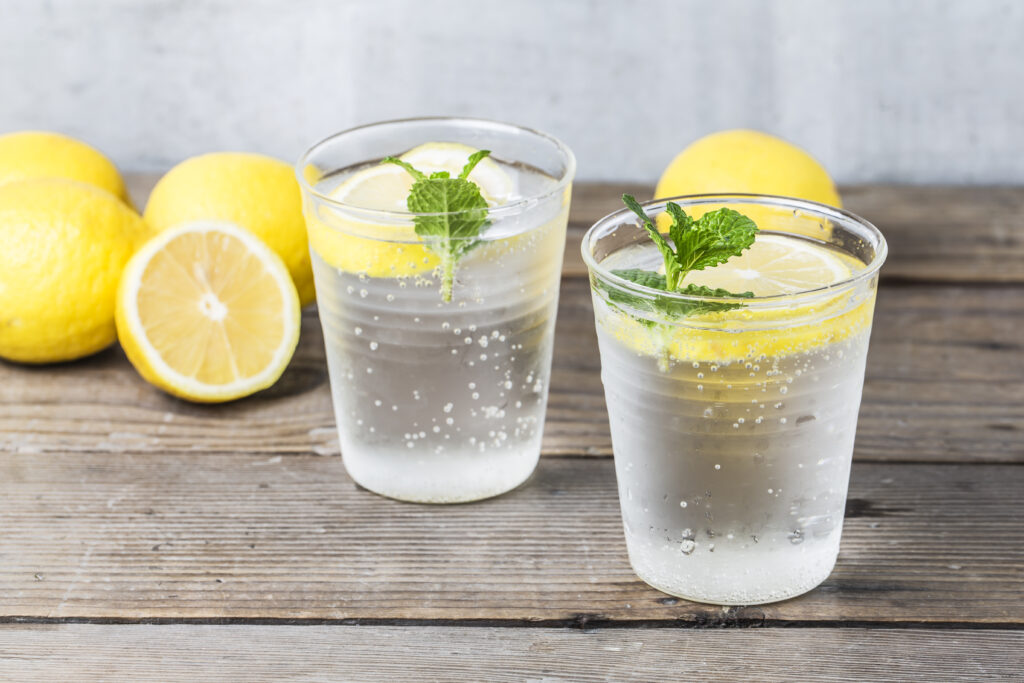
Resolution: Try adding a splash of fruit or 100% juice to enhance “sip-ability.” People who don’t enjoy water aren’t tempted to sip. The beverage companies recognize this and saturate the market with seemingly endless choices of flavored seltzers and sparkling waters. Better yet, save some money and the environment by making seltzer at home. Boost the flavor with juice or frozen juice-cubes.
Above all, quality matters. Consider the grade of what’s in your glass. Eight ounces of 100% juice is perfect for a daily serving. However, getting those nutrients from whole fruit is a healthier alternative. Therefore, the remainder of your recommended daily fruit servings should come from edible forms. Additional beverage servings should come from low calorie, high-quality sources. If you are sipping sugar-laden sodas (aka empty calories), aim to replace those with flavored seltzers or alternatives such as a caffeine-free herbal tea (iced if you prefer). Diet sodas are NOT considered high-quality. These contain artificial sweeteners and often include other ingredients such as dyes, additives, and caffeine.
Roadblock: Increasing water leads to excessive trips to the restroom.
Resolution: Start slowly and gradually increase tolerance. If you go from 50 ounces per day to more than 70 ounces per day, you will feel “the urge” more often. However, if you set a goal over a month, with weekly benchmarks to gently increase your intake, this will give your body time to acclimate. Nevertheless, the frequency of restroom trips will likely increase. Look on the bright side; more walks will force you to get up and to move throughout the day. To avoid sleep disruptions, aim to drink at least half of your water by lunchtime and decrease your consumption in the hours before bed.
Roadblock: Life is too busy, and people forget to sip throughout the day.
Resolution: To make it a habit, first, you must create a routine. Most people who are successful with their water intake will tell you that they don’t think much about it. It is a seamless part of their daily activity. This doesn’t just happen. Luckily, prompts are plentiful to assist the process. If you carry a smartphone, then you have a tracking device at your fingertips. To keep it simple, use a basic app, which acts as a notepad. Tally your drinks as you go through each day. Do you prefer some nudging or more data? Downloadable applications offer reminders and other features to watch for trends in your health. For example, the free app “My Water” allows you to track all beverages and will offset your total volume when you enter an alcoholic beverage. My Water also connects to the “Health” app for the iPhone.
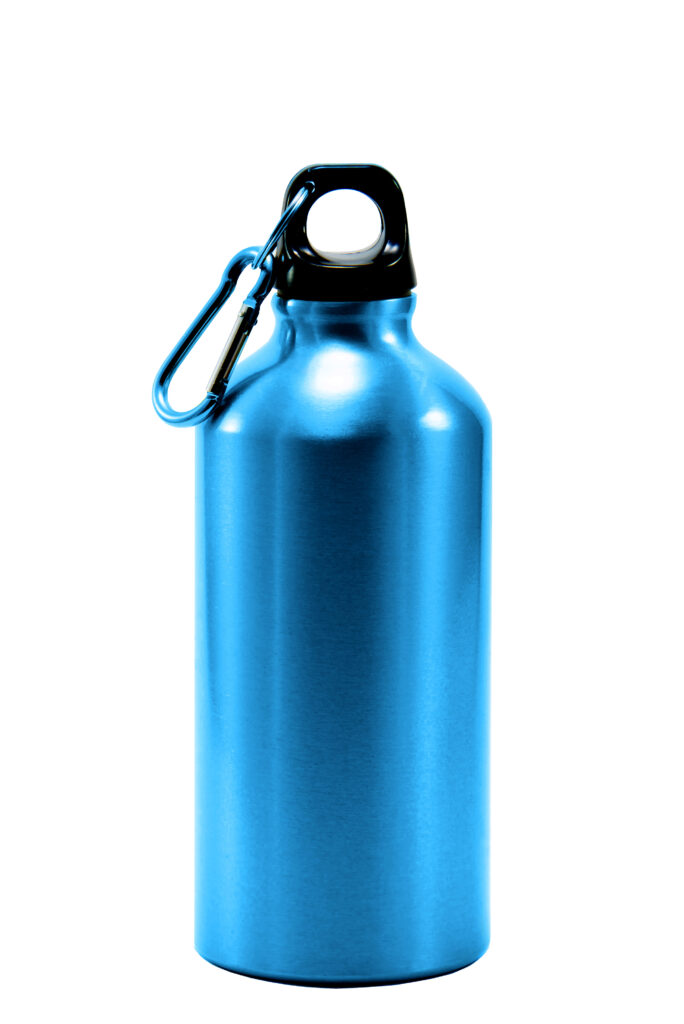
If you prefer an analog approach, add markings to your water bottle with time goals. Use elastic bands, etchings, or permanent marker to note where you should be at specific points in the day. Either way, a refillable bottle is a MUST HAVE. Buy something high quality and carry it everywhere. Steel is ideal because it keeps the beverage at a consistent temperature. Refill as needed. If you prefer flavored water at times, use two bottles; keep one reserved for plain water to reduce any lingering essence.
The fountain of youth may be that of lore. However, water is an accessible asset with a positive influence on overall health and wellness. May this entry whet your appetite and leave you thirsty for more.
TAKEAWAYS
- Water is a crucial component of overall wellness.
- Keep the quality of what you pour in mind.
- For every roadblock, you can find a resolution.
- Make it a habit. Need help? There’s an app for that.
- Most importantly, sip all day and often.
Here’s to good health.
CHEERS.
RESOURCES:
1 Functions of Water in the Body, Healthy Lifestyle Nutrition and Healthy Eating, Mayo Clinic, accessed May 2019, https://www.mayoclinic.org/healthy-lifestyle/nutrition-and-healthy-eating/multimedia/functions-of-water-in-the-body/img-20005799
2 Silver, Why is Water Important? 16 Reasons to Drink Up, Healthline, March 2019, accessed May 2019, https://www.healthline.com/health/food-nutrition/why-is-water-important
3 Dietary Reference Intakes: Water, Potassium, Sodium, Chloride, and Sulfate, The National Academies of Sciences Engineering Medicine, Health and Medicine Division, February 2004, accessed May 2019, http://www.nationalacademies.org/hmd/Reports/2004/Dietary-Reference-Intakes-Water-Potassium-Sodium-Chloride-and-Sulfate.aspx
4 Goodman et al., Behaviors and Attitudes Associated With Low Drinking Water Intake Among US Adults, Food Attitudes and Behaviors Survey, 2007, Centers for Disease Control and Prevention, April 2013, accessed May 2019, https://www.cdc.gov/pcd/issues/2013/12_0248.htm
5 Tucker et al., American Journal of Clinical Nutrition, PubMed.gov, October 2006, accessed May 2019, https://www.ncbi.nlm.nih.gov/pubmed/17023723
6 Spritzler, Carbonated (Sparkling) Water: Good or Bad?, Healthline, September 2018, accessed May 2019, https://www.healthline.com/nutrition/carbonated-water-good-or-bad#section5

